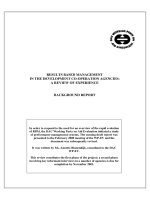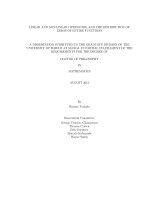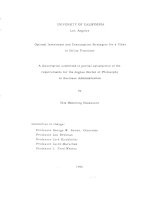DOCTOR OF MANAGEMENT IN ORGANIZATIONAL LEADERSHIP - 07/31/2011
Bạn đang xem bản rút gọn của tài liệu. Xem và tải ngay bản đầy đủ của tài liệu tại đây (76.74 KB, 10 trang )
Doctor of Management in Organizational
Leadership
TRAINING METHODS: A STUDY OF THE
TRAINING METHODS AND DATA
RETENTION OF
ADULTS IN THE BANKING INDUSTRY
Significance
•
267 banking citations during the 6 years prior
to 9-11.
•
442 citations during the 6 years after 9-11,
representing a 65.5% increase.
•
Monetary fines accessed for the 6 years prior
to 9-11 were $976,400, as compared to the
fines accessed for the 6 years post 9-11 of
$82,034,000, which represents an 830%
increase. (www.occ.treas.gov)
Relevance to Study
•
Court documents filed by the OCC revealed
that “ineffective” training was commonly listed
as a compliance deficiency.
•
OCC vs. Riggs Bank, N.A. of McLean, TX.
The OCC specifically cited that, “The Bank’s
numerous BSA-related deficiencies demonstrate
that the Bank’s training program was
ineffective.” The Riggs Bank case resulted in a
$25,000,000 civil money penalty. (
www.occ.treas.gov/FTP/EAs/ea2004-44.pdf)
Relevance to Study
•
USA Patriot Act significantly increased the training
requirements for the banking industry.
•
The banking industry was faced with a need to
change their training procedures.
•
Many banks moved from FTF training to CBT.
•
•
Study Question: Is CBT as effective as FTF?
•
Study Question: Which promotes greater
knowledge retention?
Research Method
•
Quantitative quasi-experimental
research study.
•
Population under investigation - 30
randomly selected bank employees
representing 57% of the sample
population of a small national bank with
5 locations in Kansas.
Research Study
•
Step 1 - pre-test all 30 participants to
baseline knowledge.
•
Step 2 - Group A - 15 participants will receive
FTF training.
Group B – 15 participants will receive CBT.
•
Step 3 - Post-test to measure increment of
change in test scores between the
two training methods.
•
Step 4 - Re-test 30 days later for retention.
Design Appropriateness
•
The quantitative quasi-experimental method provided
a viable method in the research design by using a pre-
test and post-test model in conducting the analysis.
(Campbell & Stanley, 1963)
•
Quantitative research designs are appropriate when
correlating, measuring, and examining casual
relationships among variables.
(Creswell, 2003)
How Data Will Be Collected
•
Participants will be coded A1 through A15
(Group A) and B1 through B15 (Group B).
•
Pre-test scores will be recorded for each
participant.
•
After training, participants will complete a
post-test and those scores will be recorded for
each participant.
•
A repeat test will be given 30 days after
training to measure retention.
How Data Will Be Analyzed
Sample Coding Sheet
Step 1 Step 2 Step 3 Increment Step 4 Increment
Pre-test Training Post-test Change Retention Change
A1 70 FTF 85 +15 75 -10
A2 65 FTF 75 +10 70 - 5
A3
A4
B1 75 CBT 90 +15 75 -15
B2 85 CBT 100 +15 90 -10
B3
B4
References
•
Campbell, D., & Stanley, J. (1963). Experimental
and quasi-experimental designs for research.
Boston: Houghton Mifflin Company.
•
Creswell, J., (2003).
Research Design; Qualitative, Quantitaive,
and Mixed Methods Approaches (2nd ed.)
Sage Publications, Inc.









